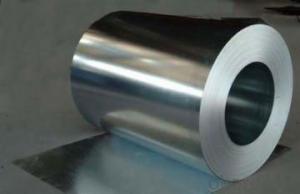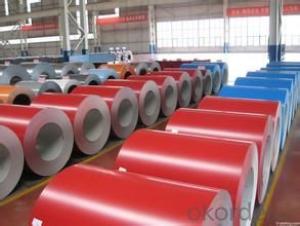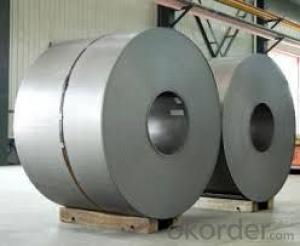Galvanized/Aluzinc Steel Sheet or Coil in High Quality
- Loading Port:
- Shanghai
- Payment Terms:
- TT OR LC
- Min Order Qty:
- 100 m.t.
- Supply Capability:
- 10000 m.t./month
OKorder Service Pledge
OKorder Financial Service
You Might Also Like
Hot-dip Zinc Coating Steel Building Roof Walls
1.Structure of Hot-Dip Galvanized Steel Sheet Description:
Hot-dip galvanized steel coils are available with a pure zinc coating through the hot-dip galvanizing process. It offers the economy, strength and formability of steel combined with the corrosion resistance of zinc. The hot-dip process is the process by which steel gets coated in layers of zinc to protect against rust. It is especially useful for countless outdoor and industrial applications. Production of cold formed corrugated sheets and profiles for roofing, cladding, decking, tiles, sandwich walls, rainwater protective systems, air conditioning duct as well as electrical appliances and engineering.
2.Main Features of the Hot-Dip Galvanized Steel Sheet:
• Excellent process capability
• Smooth and flat surface
• Workability, durability
• Excellent anticorrosive property
• High strength
• Good formability
• Good visual effect
3.Hot-Dip Galvanized Steel Sheet Images:

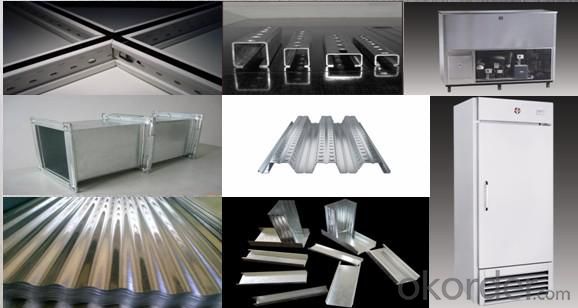
4.Hot-Dip Galvanized Steel Sheet Specification:
Standard: ASTM, JIS,EN
Grade: CS, DX51D+Z,SGCC, SS 230~550,S220GD+Z~S550GD+Z, SGC340~SGC570
Thickness: 0.1mm~5mm
Width: max 2000mm
Coil weight:3-12 MT
Coil ID:508/610mm
Surface structure: zero spangle, regular spangle or minimum spangle
Surface treatment: Chromate treatment, Oiled/dry, skinpassed/non-skinpassed
Packing: Standard seaworthy export package
Technology test results:
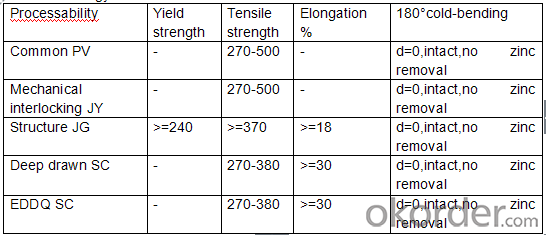
5.FAQ of Hot-Dip Galvanized Steel Sheet:
We have organized several common questions for our clients,may help you sincerely:
1.How about your company?
A world class manufacturer & supplier of castings forging in carbon steel and alloy steel,is one of the large-scale professional investment casting production bases in China,consisting of both casting foundry forging and machining factory. Annually more than 8000 tons Precision casting and forging parts are exported to markets in Europe,America and Japan. OEM casting and forging service available according to customer’s requirements.
2.How to guarantee the quality of the products?
We have established the international advanced quality management system,every link from raw material to final product we have strict quality test;We resolutely put an end to unqualified products flowing into the market. At the same time, we will provide necessary follow-up service assurance.
3. How long can we receive the product after purchase?
Usually within thirty working days after receiving buyer’s advance payment or LC. We will arrange the factory manufacturing as soon as possible. The cargo readiness usually takes 15-30 days, but the shipment will depend on the vessel situation.
- Q:What kind of material does ordinary steel plate refer to in steel market?
- When we use high temperature resistant, steel plate are sometimes exposed to outdoor or there is a very high temperature, but our common plate is very weak in high temperature resistance, this is mainly because the composition of carbon and iron is very weak. But the alloy steel plate has solved this problem, because other alloy elements join, our alloy steel plate in the metal element combination aspect has obtained the very good solution.
- Q:What is the maximum width of steel sheets?
- The maximum width of steel sheets can vary depending on the specific type and grade of steel, but it typically ranges from 72 inches to 96 inches.
- Q:What is the average thickness of galvanized steel sheets?
- The specific application and industry standards can cause variations in the average thickness of galvanized steel sheets. Generally, galvanized steel sheets that are commonly accessible have a thickness ranging from approximately 0.4 millimeters to 3.175 millimeters. It is crucial to recognize that heavier galvanized steel sheets are frequently utilized for robust applications like construction and industrial purposes, whereas thinner sheets may be suitable for lighter applications such as automotive or household appliances. Furthermore, it is recommended to refer to the appropriate industry standards or manufacturers' specifications to determine the exact thickness requirements for specific applications.
- Q:What is the process of laminating steel sheets?
- The process of laminating steel sheets involves several steps to create a composite material that is stronger and more durable than traditional steel. First, the steel sheets are cleaned and prepped to remove any impurities or contaminants. This is important to ensure a strong bond between the layers and prevent any defects in the final product. Next, a layer of adhesive is applied to one or both sides of the steel sheets. The adhesive can be a thermosetting resin or a thermoplastic material, depending on the desired properties of the laminated steel. After the adhesive is applied, the steel sheets are stacked together, with the adhesive layer(s) in between. The sheets are then subjected to high temperature and pressure to initiate the bonding process. This can be done using a hydraulic press or a hot rolling mill. The combination of heat and pressure causes the adhesive to melt and flow, creating a strong chemical bond between the steel sheets. The high pressure ensures that the adhesive is evenly distributed and fills any gaps or irregularities between the sheets. Once the bonding process is complete, the laminated steel sheets are cooled and trimmed to the desired size and shape. They can then be further processed, such as by cutting, bending, or welding, to meet specific application requirements. Overall, the process of laminating steel sheets involves cleaning and prepping the sheets, applying adhesive, stacking the sheets, subjecting them to high temperature and pressure, cooling, and finalizing the shape. This process results in a composite material with improved strength, corrosion resistance, and other desirable properties compared to traditional steel.
- Q:Are steel sheets resistant to bullet penetration?
- Yes, steel sheets are generally resistant to bullet penetration due to their high hardness and strength. However, the degree of resistance may vary depending on the thickness and quality of the steel.
- Q:What is the process of applying protective coatings to steel sheets?
- The process of applying protective coatings to steel sheets typically involves several steps. First, the steel sheets are thoroughly cleaned and prepared to ensure a clean and smooth surface. This may involve removing any existing rust, dirt, or contaminants. Next, a primer or base coat is applied to the steel sheets. The primer helps to promote adhesion between the steel surface and the protective coating. It also provides additional corrosion resistance. After the primer has dried, the main protective coating is applied. This coating can vary depending on the specific requirements and intended use of the steel sheets. Common types of protective coatings for steel include epoxy, polyurethane, or powder coatings. The coating is carefully applied to ensure an even and consistent coverage. Once the protective coating has been applied, the steel sheets are typically cured or dried according to the manufacturer's instructions. This allows the coating to fully bond and harden, increasing its durability and resistance to corrosion. Overall, the process of applying protective coatings to steel sheets involves cleaning and preparing the surface, applying a primer, applying the main protective coating, and properly curing or drying the coating to ensure optimal performance.
- Q:How do you remove stains or marks from steel sheets?
- To remove stains or marks from steel sheets, you can start by wiping the surface with a clean cloth soaked in warm soapy water. For tougher stains, you can try using a mild abrasive cleaner or a mixture of baking soda and water to gently scrub the affected area. If the stain persists, you can use a non-abrasive stainless steel cleaner or vinegar to further remove the marks. Remember to rinse the steel sheet thoroughly and dry it properly to prevent any water spots or residue.
- Q:Can steel sheets be used for cladding?
- Yes, steel sheets can be used for cladding.
- Q:What is the process of powder coating steel sheets?
- The process of powder coating steel sheets involves several steps. First, the steel sheets are cleaned to remove any dirt, oil, or rust. This is usually done through a process called pre-treatment, which includes washing and chemical treatment. Once the sheets are clean, they are dried thoroughly to ensure proper adhesion of the powder coating. Next, a dry powder coating material is applied to the steel sheets using a special spray gun or electrostatic fluidized bed. The powder consists of finely ground particles that contain pigments, resins, and additives. When the powder is applied, it adheres electrostatically to the grounded metal surface. After the powder is applied, the steel sheets are cured in an oven or a heating chamber. The heat causes the powder coating to melt and flow, forming a smooth and durable finish. The curing process typically takes a few minutes and is done at a specific temperature according to the powder coating manufacturer's instructions. Once the sheets are cured, they are cooled down and inspected for any defects or imperfections. If necessary, touch-up or repair work may be done at this stage. Finally, the powder-coated steel sheets are ready for packaging and shipping. Overall, the process of powder coating steel sheets involves cleaning, powder application, curing, and inspection, resulting in a protective and aesthetically pleasing finish.
- Q:Can steel sheets be welded or joined together?
- Yes, steel sheets can be welded or joined together using various welding techniques such as arc welding, MIG welding, or TIG welding.
1. Manufacturer Overview |
|
|---|---|
| Location | |
| Year Established | |
| Annual Output Value | |
| Main Markets | |
| Company Certifications | |
2. Manufacturer Certificates |
|
|---|---|
| a) Certification Name | |
| Range | |
| Reference | |
| Validity Period | |
3. Manufacturer Capability |
|
|---|---|
| a)Trade Capacity | |
| Nearest Port | |
| Export Percentage | |
| No.of Employees in Trade Department | |
| Language Spoken: | |
| b)Factory Information | |
| Factory Size: | |
| No. of Production Lines | |
| Contract Manufacturing | |
| Product Price Range | |
Send your message to us
Galvanized/Aluzinc Steel Sheet or Coil in High Quality
- Loading Port:
- Shanghai
- Payment Terms:
- TT OR LC
- Min Order Qty:
- 100 m.t.
- Supply Capability:
- 10000 m.t./month
OKorder Service Pledge
OKorder Financial Service
Similar products
New products
Hot products
Hot Searches
Related keywords
